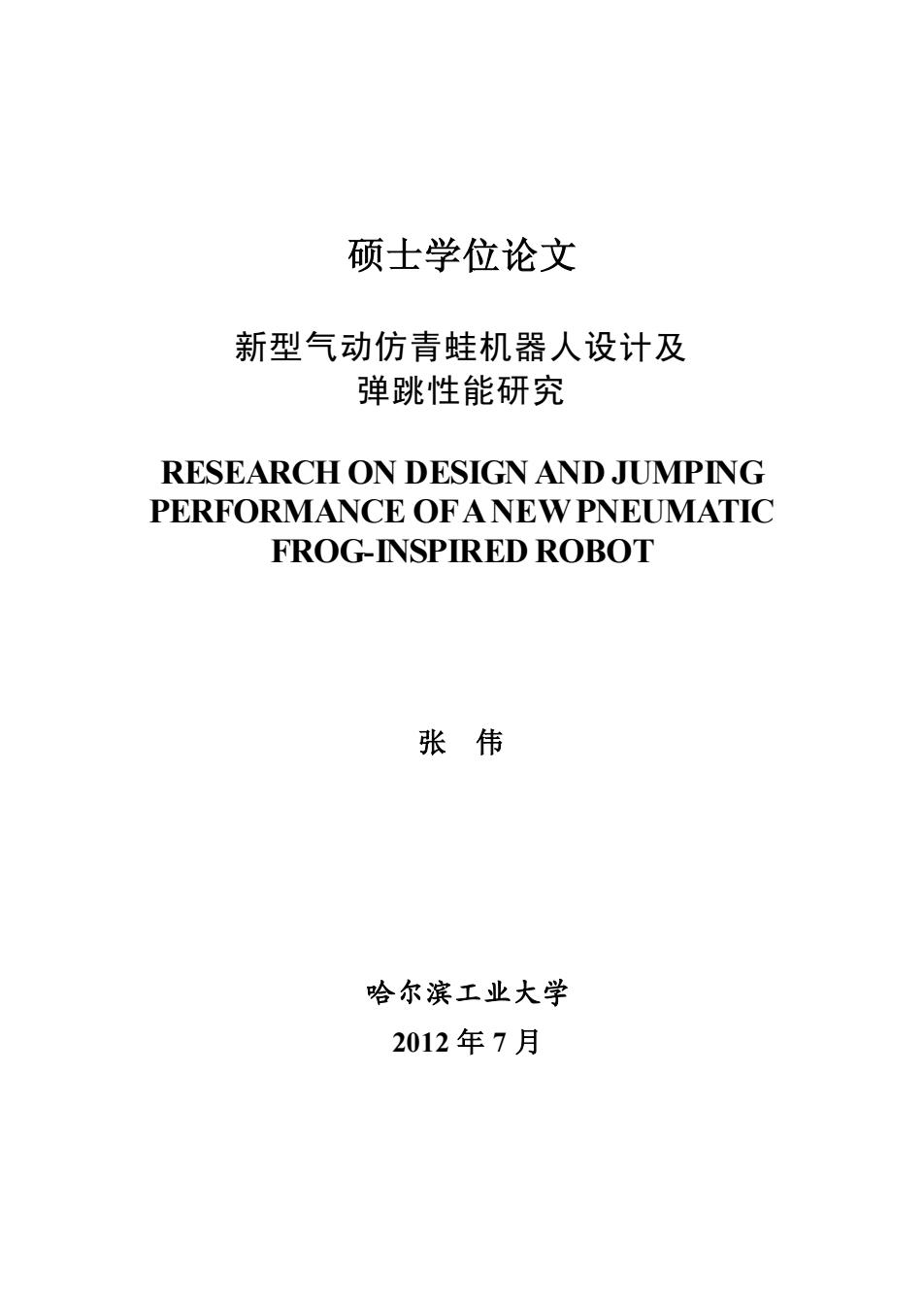
硕士学位论文 新型气动仿青蛙机器人设计及 弹跳性能研究 RESEARCH ON DESIGN AND JUMPING PERFORMANCE OFANEWPNEUMATIC FROG-INSPIRED ROBOT 张伟 哈尔滨工业大学 2012年7月
- 硕士学位论文 新型气动仿青蛙机器人设计及 弹跳性能研究 RESEARCH ON DESIGN AND JUMPING PERFORMANCE OF A NEW PNEUMATIC FROG-INSPIRED ROBOT 张 伟 哈尔滨工业大学 2012 年 7 月
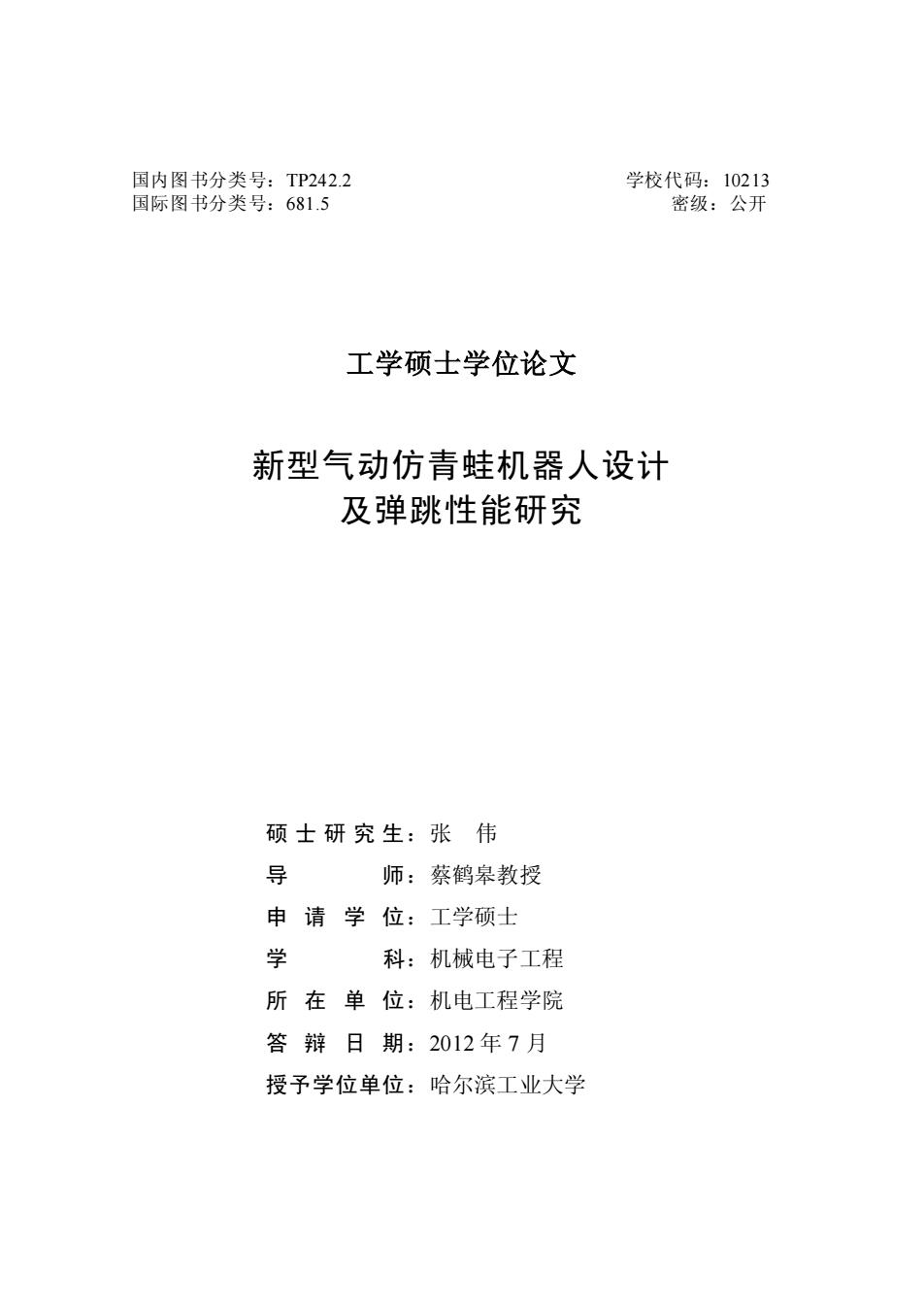
国内图书分类号:TP242.2 学校代码:10213 国际图书分类号:681.5 密级:公开 工学硕士学位论文 新型气动仿青蛙机器人设计 及弹跳性能研究 硕士研究生:张伟 导 师:蔡鹤皋教授 申请学位:工学硕士 学 科:机械电子工程 所在单位:机电工程学院 答辩日期:2012年7月 授予学位单位:哈尔滨工业大学
- 国内图书分类号:TP242.2 学校代码:10213 国际图书分类号:681.5 密级:公开 工学硕士学位论文 新型气动仿青蛙机器人设计 及弹跳性能研究 硕士研究生:张 伟 导 师:蔡鹤皋教授 申 请 学 位:工学硕士 学 科:机械电子工程 所 在 单 位:机电工程学院 答 辩 日 期:2012 年 7 月 授予学位单位:哈尔滨工业大学
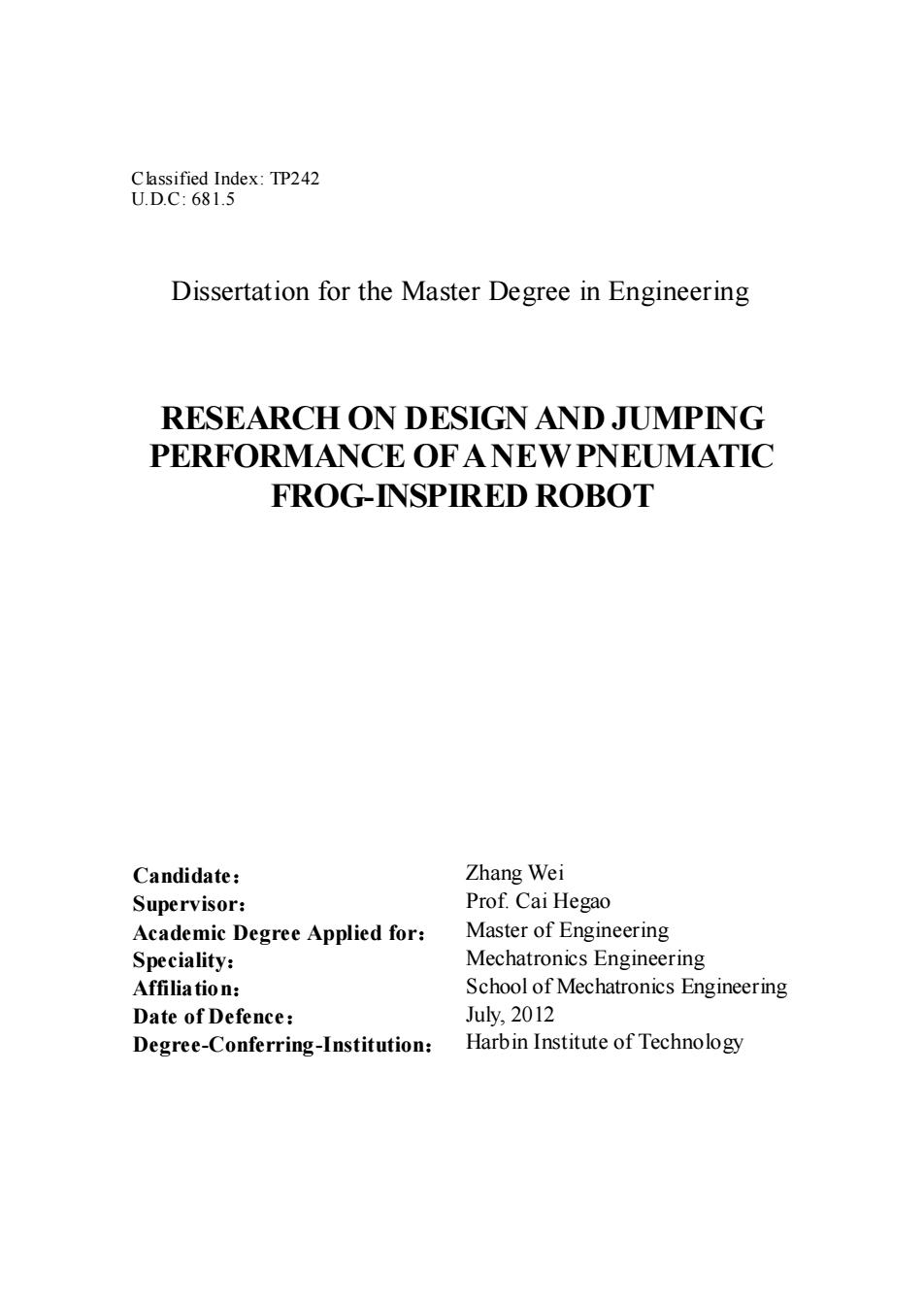
Classified Index:TP242 U.D.C:681.5 Dissertation for the Master Degree in Engineering RESEARCH ON DESIGN AND JUMPING PERFORMANCE OF ANEWPNEUMATIC FROG-INSPIRED ROBOT Candidate: Zhang Wei Supervisor: Prof.Cai Hegao Academic Degree Applied for: Master of Engineering Speciality: Mechatronics Engineering Affiliation: School of Mechatronics Engineering Date of Defence: Juy,2012 Degree-Conferring-Institution: Harbin Institute of Technology
- Classified Index: TP242 U.D.C: 681.5 Dissertation for the Master Degree in Engineering RESEARCH ON DESIGN AND JUMPING PERFORMANCE OF A NEW PNEUMATIC FROG-INSPIRED ROBOT Candidate: Zhang Wei Supervisor: Prof. Cai Hegao Academic Degree Applied for: Master of Engineering Speciality: Mechatronics Engineering Affiliation: School of Mechatronics Engineering Date of Defence: July, 2012 Degree-Conferring-Institution: Harbin Institute of Technology
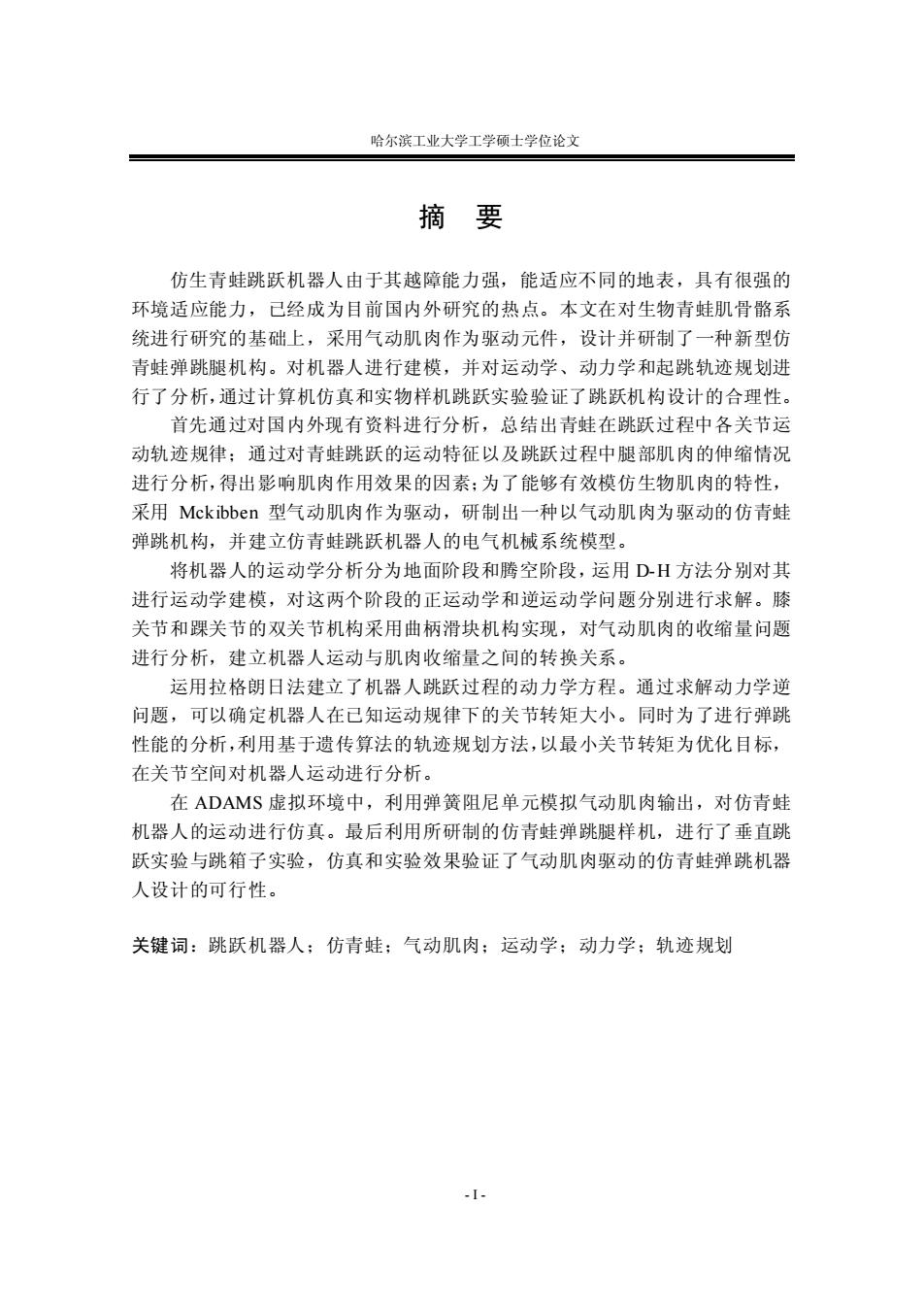
哈尔滨工业大学工学硕士学位论文 摘 要 仿生青蛙跳跃机器人由于其越障能力强,能适应不同的地表,具有很强的 环境适应能力,已经成为目前国内外研究的热点。本文在对生物青蛙肌骨骼系 统进行研究的基础上,采用气动肌肉作为驱动元件,设计并研制了一种新型仿 青蛙弹跳腿机构。对机器人进行建模,并对运动学、动力学和起跳轨迹规划进 行了分析,通过计算机仿真和实物样机跳跃实验验证了跳跃机构设计的合理性。 首先通过对国内外现有资料进行分析,总结出青蛙在跳跃过程中各关节运 动轨迹规律:通过对青蛙跳跃的运动特征以及跳跃过程中腿部肌肉的伸缩情况 进行分析,得出影响肌肉作用效果的因素:为了能够有效模仿生物肌肉的特性, 采用Mckibben型气动肌肉作为驱动,研制出一种以气动肌肉为驱动的仿青蛙 弹跳机构,并建立仿青蛙跳跃机器人的电气机械系统模型。 将机器人的运动学分析分为地面阶段和腾空阶段,运用D-H方法分别对其 进行运动学建模,对这两个阶段的正运动学和逆运动学问题分别进行求解。膝 关节和踝关节的双关节机构采用曲柄滑块机构实现,对气动肌肉的收缩量问题 进行分析,建立机器人运动与肌肉收缩量之间的转换关系。 运用拉格朗日法建立了机器人跳跃过程的动力学方程。通过求解动力学逆 问题,可以确定机器人在已知运动规律下的关节转矩大小。同时为了进行弹跳 性能的分析,利用基于遗传算法的轨迹规划方法,以最小关节转矩为优化目标, 在关节空间对机器人运动进行分析。 在ADAMS虚拟环境中,利用弹簧阻尼单元模拟气动肌肉输出,对仿青蛙 机器人的运动进行仿真。最后利用所研制的仿青蛙弹跳腿样机,进行了垂直跳 跃实验与跳箱子实验,仿真和实验效果验证了气动肌肉驱动的仿青蛙弹跳机器 人设计的可行性。 关键词:跳跃机器人;仿青蛙:气动肌肉:运动学:动力学:轨迹规划 -I-
哈尔滨工业大学工学硕士学位论文 - I - 摘 要 仿生青蛙跳跃机器人由于其越障能力强,能适应不同的地表,具有很强的 环境适应能力,已经成为目前国内外研究的热点。本文在对生物青蛙肌骨骼系 统进行研究的基础上,采用气动肌肉作为驱动元件,设计并研制了一种新型仿 青蛙弹跳腿机构。对机器人进行建模,并对运动学、动力学和起跳轨迹规划进 行了分析,通过计算机仿真和实物样机跳跃实验验证了跳跃机构设计的合理性。 首先通过对国内外现有资料进行分析,总结出青蛙在跳跃过程中各关节运 动轨迹规律;通过对青蛙跳跃的运动特征以及跳跃过程中腿部肌肉的伸缩情况 进行分析,得出影响肌肉作用效果的因素;为了能够有效模仿生物肌肉的特性, 采用 Mckibben 型气动肌肉作为驱动,研制出一种以气动肌肉为驱动的仿青蛙 弹跳机构,并建立仿青蛙跳跃机器人的电气机械系统模型。 将机器人的运动学分析分为地面阶段和腾空阶段,运用 D-H 方法分别对其 进行运动学建模,对这两个阶段的正运动学和逆运动学问题分别进行求解。膝 关节和踝关节的双关节机构采用曲柄滑块机构实现,对气动肌肉的收缩量问题 进行分析,建立机器人运动与肌肉收缩量之间的转换关系。 运用拉格朗日法建立了机器人跳跃过程的动力学方程。通过求解动力学逆 问题,可以确定机器人在已知运动规律下的关节转矩大小。同时为了进行弹跳 性能的分析,利用基于遗传算法的轨迹规划方法,以最小关节转矩为优化目标, 在关节空间对机器人运动进行分析。 在 ADAMS 虚拟环境中,利用弹簧阻尼单元模拟气动肌肉输出,对仿青蛙 机器人的运动进行仿真。最后利用所研制的仿青蛙弹跳腿样机,进行了垂直跳 跃实验与跳箱子实验,仿真和实验效果验证了气动肌肉驱动的仿青蛙弹跳机器 人设计的可行性。 关键词:跳跃机器人;仿青蛙;气动肌肉;运动学;动力学;轨迹规划
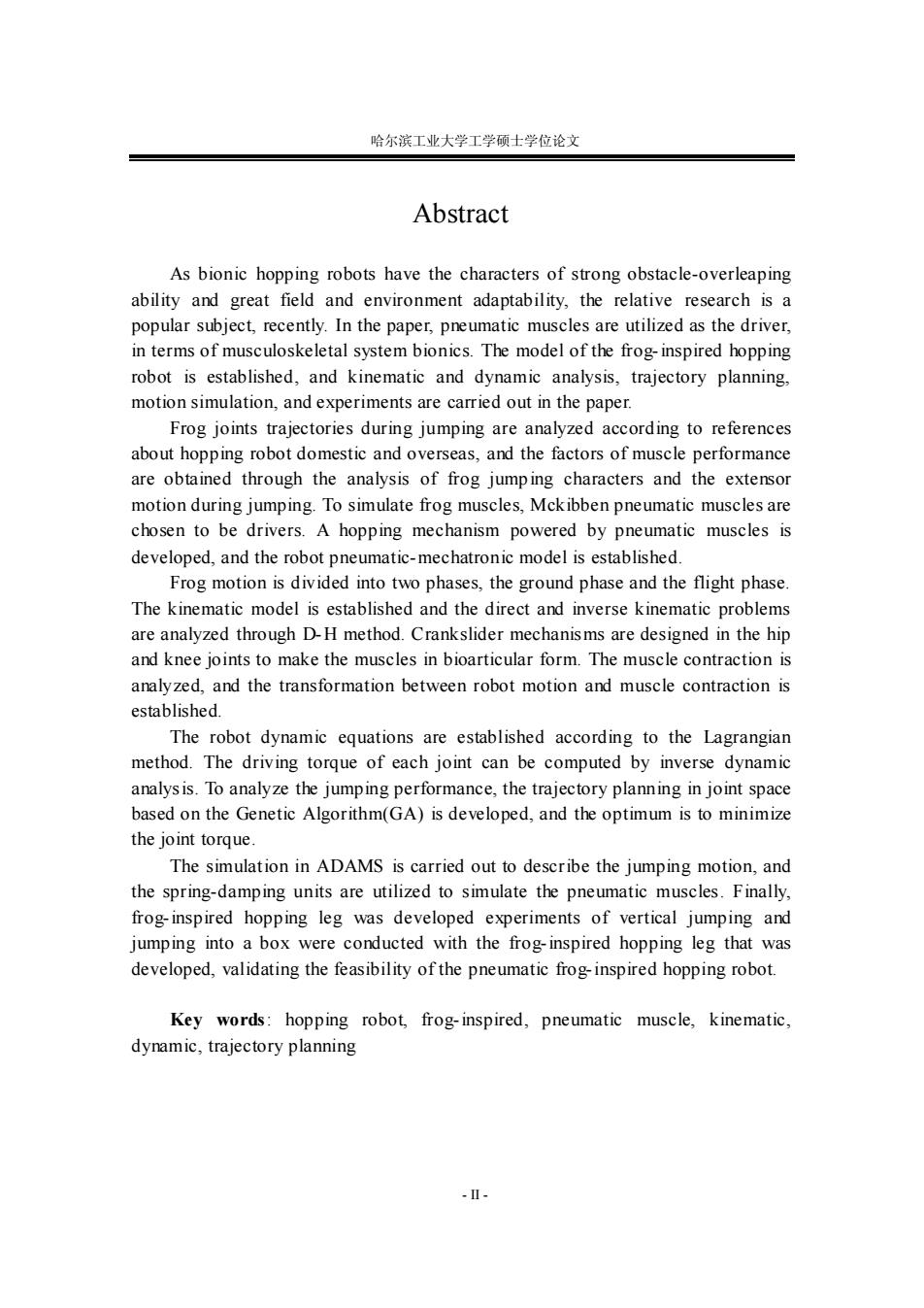
哈尔滨工业大学工学硕士学位论文 Abstract As bionic hopping robots have the characters of strong obstacle-overleaping ability and great field and environment adaptability,the relative research is a popular subject,recently.In the paper,pneumatic muscles are utilized as the driver, in terms of musculoskeletal system bionics.The model of the frog-inspired hopping robot is established,and kinematic and dynamic analysis,trajectory planning. motion simulation,and experiments are carried out in the paper. Frog joints trajectories during jumping are analyzed according to references about hopping robot domestic and overseas,and the factors of muscle performance are obtained through the analysis of frog jumping characters and the extensor motion during jumping.To simulate frog muscles,Mckibben pneumatic muscles are chosen to be drivers.A hopping mechanism powered by pneumatic muscles is developed,and the robot pneumatic-mechatronic model is established. Frog motion is divided into two phases,the ground phase and the flight phase. The kinematic model is established and the direct and inverse kinematic problems are analyzed through D-H method.Crankslider mechanisms are designed in the hip and knee joints to make the muscles in bioarticular form.The muscle contraction is analyzed,and the transformation between robot motion and muscle contraction is established. The robot dynamic equations are established according to the Lagrangian method.The driving torque of each joint can be computed by inverse dynamic analys is.To analyze the jumping performance,the trajectory planning in joint space based on the Genetic Algorithm(GA)is developed,and the optimum is to minimize the joint torque. The simulation in ADAMS is carried out to describe the jumping motion,and the spring-damping units are utilized to simulate the pneumatic muscles.Finally, frog-inspired hopping leg was developed experiments of vertical jumping and jumping into a box were conducted with the frog-inspired hopping leg that was developed,validating the feasibility of the pneumatic frog-inspired hopping robot. Key words:hopping robot,frog-inspired,pneumatic muscle,kinematic, dynamic,trajectory planning -1-
哈尔滨工业大学工学硕士学位论文 - II - Abstract As bionic hopping robots have the characters of strong obstacle-overleaping ability and great field and environment adaptability, the relative research is a popular subject, recently. In the paper, pneumatic muscles are utilized as the driver, in terms of musculoskeletal system bionics. The model of the frog-inspired hopping robot is established, and kinematic and dynamic analysis, trajectory planning, motion simulation, and experiments are carried out in the paper. Frog joints trajectories during jumping are analyzed according to references about hopping robot domestic and overseas, and the factors of muscle performance are obtained through the analysis of frog jumping characters and the extensor motion during jumping. To simulate frog muscles, Mckibben pneumatic muscles are chosen to be drivers. A hopping mechanism powered by pneumatic muscles is developed, and the robot pneumatic-mechatronic model is established. Frog motion is divided into two phases, the ground phase and the flight phase. The kinematic model is established and the direct and inverse kinematic problems are analyzed through D-H method. Crankslider mechanisms are designed in the hip and knee joints to make the muscles in bioarticular form. The muscle contraction is analyzed, and the transformation between robot motion and muscle contraction is established. The robot dynamic equations are established according to the Lagrangian method. The driving torque of each joint can be computed by inverse dynamic analysis. To analyze the jumping performance, the trajectory planning in joint space based on the Genetic Algorithm(GA) is developed, and the optimum is to minimize the joint torque. The simulation in ADAMS is carried out to describe the jumping motion, and the spring-damping units are utilized to simulate the pneumatic muscles. Finally, frog-inspired hopping leg was developed experiments of vertical jumping and jumping into a box were conducted with the frog-inspired hopping leg that was developed, validating the feasibility of the pneumatic frog-inspired hopping robot. Key words: hopping robot, frog-inspired, pneumatic muscle, kinematic, dynamic, trajectory planning